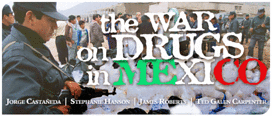The three reaction essays do not only reflect different points of view (logically enough) but they also address very different issues. I will very quickly respond to several points raised by James Roberts, because they involve a much broader set of questions than the central theme of my original essay, and then address some of the specific points raised by Ted Galen Carpenter and Stephanie Hanson.
Mr. Roberts perhaps too generously identifies the views of the “Mexican elites” with my own; I wish I were as representative as he seems to believe. In fact, I have tried over the past quarter century to avoid “blaming” anyone, much less the U.S. for Mexico’s challenges, other than to point out that most of Mexico’s challenges have an inevitable bilateral component, given the intensity of the relationship between the two countries. No one “blames” Richard Nixon for “the current drug problem”; I just made a statement of fact that, for those who might think that these matters are novel, the first major crisis in US-Mexican relations over drugs occurred in 1969, when then-President Nixon implemented Operation Intercept. Similarly, I have tried over the years to point out that while Mr. Roberts and others may sincerely believe that out-migration from Mexico began in the seventies or eighties when the “Mexican Miracle” fizzled out, in fact migration began in the late nineteenth century, passed through the Bracero Agreement in 1942-1964, and has continued ever since, having nothing to do with elites one way or another. Finally, I do not address the question of Chavez, Zelaya, etc, not because I do not think they are important, but because I was under the impression that the center of the debate was elsewhere.
The essential point on the current drug war in Mexico that I wanted to make, and that I will repeat here, is that there is an enormous imbalance between means and ends. If President Calderon wants to take on “all the cartels, all the time” and make it so expensive, difficult and dangerous for them to use Mexico as a route for introducing drugs to the U.S. market, given that there is no reason to believe that U.S. demand will drop any time soon, then he needs much more support from the U.S. for this effort than what he has asked for, or than what the U.S. (Bush and Obama) has offered. That support can only materialize, in a significant way, through a much greater U.S. physical presence in Mexico, not only in intelligence and DEA agents, but mainly in training, advising and accompanying Mexican forces. That is not going to happen, for reasons President Calderon himself has insisted upon; whether it would be effective or not — a point Ted Galen Carpenter rightly raises, is almost a moot question. The reason I point out that Plan Colombia is essentially a counter-insurgency program is that it has not reduced Colombian coca leaf acreage, production, or exports, but has permitted a major dismantling of the FARC guerrillas. This is a desirable outcome, but irrelevant to Mexico, and not the original purpose of the exercise.
I tend to agree with Carpenter that most of these efforts, even “sealing off” the southern Mexican border — which would not help the U.S., but, if successful, would help Mexico — probably would not work, but the case for legalization can probably only be made if such an attempt is seriously made and is shown to be futile. The main point on which I agree with Ted Galen Carpenter involves legalization as the only long-term solution, but I insist that without accompanying movement in the US, Mexico cannot go it alone. Neither politically nor from a security or public health perspective is this viable. I do increasingly believe that Mexico should lobby the U.S. in favor of decriminalization, and should make its stance known, but on the understanding that it cannot act unilaterally.
Finally, in relation to Stephanie Hanson’s point about gun traffic, I do have a bit of a quarrel with the figures she quotes. The Mexican Embassy’s numbers unfortunately are not reliable, nor is it a reliable source; if nearly one million weapons were entering Mexico yearly since 2004, there would be more guns in Mexico than in Brazil, for example, or Colombia. The fact is that we only know for sure that 90 percent of the traceable weapons actually traced in Mexico come from the US, most of them from the secondary market which is even more difficult to control than the gun store and gun show market. It is far more likely that a large majority of the weapons preferred by the cartels in Mexico — AK-47s or cuernos de chivo without serial numbers — come from the former Soviet Union, China etc., and from the Central American wars of the eighties and early nineties. So I do not think that enhanced weapon-flow control from north to south will make much difference, and it can wreak havoc with trade and tourism flows, which are already down and dropping.
We can return to these points in the next couple of days.

